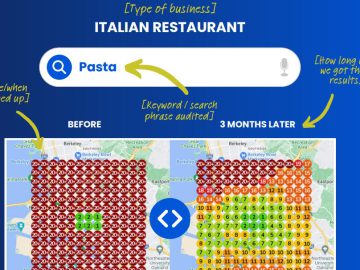In today’s competitive digital landscape, having a strong Google Business Profile (GBP) is crucial for businesses looking to boost their online presence and attract local customers. However, merely having a profile isn’t enough. To truly thrive, it’s essential to generate organic visits for Google Business Profile, grow Google Business Profile audience, and understand the best SEO practices, such as how to use H1 tags efficiently. In this guide, we’ll dive deep into these topics, offering valuable insights and practical strategies to help your business stand out.
Why Your Google Business Profile Matters
Before we dive into tactics, let’s quickly cover why your Google Business Profile is a game-changer for your business. A well-optimized Google Business Profile acts as a local search engine optimization (SEO) tool, helping potential customers find you when they search for businesses or services you offer in your area. A fully optimized profile improves visibility in Google Maps and search results, making it easier for people to discover your business. The more visits your profile generates, the better your local ranking becomes, which in turn drives more organic traffic and customers.
Generate Organic Visits for Google Business Profile
Generating organic visits for Google Business Profile requires a combination of effective SEO techniques, strategic content creation, and constant engagement. The first step to achieving this is ensuring your profile is fully completed and accurate. Businesses that provide complete information are twice as likely to be considered reputable by consumers. Here’s a breakdown of actionable steps to help you generate organic visits for Google Business Profile:
-
Optimize Your Business Information: Ensure that all your business information, such as name, address, phone number, and business hours, is accurate and consistent across all platforms. Google rewards businesses that provide consistent data across the web. If your details change, update them promptly on your Google Business Profile and other online directories.
-
Leverage Local Keywords: To generate organic visits, local SEO is key. Use local keywords in your business description, posts, and responses to reviews. For example, if you own a bakery in downtown Chicago, incorporate terms like “best bakery in downtown Chicago” into your profile description. This boosts your chances of appearing in local search results.
-
Add High-Quality Images and Videos: Posts with images and videos are more engaging, which can lead to increased organic visits. Showcase the best aspects of your business by uploading high-resolution photos and videos. Geotagging your images and videos with your business location further enhances your local SEO efforts, making it easier for potential customers to find you.
-
Encourage Customer Reviews: Google highly values reviews as a ranking factor. Encourage satisfied customers to leave positive reviews. Not only do reviews improve trust, but they also increase visibility and click-through rates. Remember to respond to reviews-both positive and negative-to show you care about customer feedback.
-
Post Regular Updates: Use the “Posts” feature to share news, offers, and updates about your business. These posts can help you generate organic visits as they allow you to appear in the “Updates” tab on Google Business Profiles. Keep your audience informed about upcoming events, promotions, or new products/services.
-
Use Google Q&A Effectively: The Questions & Answers section is an underutilized feature on Google Business Profiles. Provide helpful answers to frequently asked questions and seed your own Q&A to control the narrative and provide useful information to potential customers.
-
Track and Improve with Google Insights: Use Google Business Profile Insights to monitor how your audience interacts with your profile. Insights provide valuable data on how customers find your profile, how many visits you receive, and what actions customers take. Use this data to optimize your content and SEO strategy.
Grow Google Business Profile Audience
Growing your Google Business Profile audience is about more than just optimizing for search. It requires continuous engagement and strategic promotion. Here are steps to grow your audience organically:
-
Utilize Social Media Integration: Promote your Google Business Profile across your social media channels. Share your profile link in posts, stories, and bios to drive traffic. Encourage your followers on platforms like Instagram, Facebook, and Twitter to follow your business on Google.
-
Run Google Ads with Local Extensions: Although this involves paid efforts, using Google Ads with location extensions can significantly boost the visibility of your Google Business Profile. Local extensions show your profile alongside your ad, offering customers a direct link to your business information.
-
Encourage User-Generated Content: Customers are more likely to trust user-generated content. Encourage your audience to post images, reviews, and experiences about your business directly on your Google Business Profile. Engaging content such as these creates social proof and helps grow your organic audience.
-
Collaborate with Local Influencers and Businesses: Partnering with local influencers or businesses can help you reach a broader audience. For example, if you own a restaurant, collaborating with a local food blogger can increase your exposure and attract new customers who might leave reviews or check-in on your Google Business Profile.
-
Host Local Events and Promote via Google Posts: Hosting local events can help increase foot traffic and online engagement. Use Google Posts to promote the events, and encourage attendees to leave reviews and upload pictures, thus further expanding your audience.
-
Respond to Customer Inquiries and Reviews Quickly: Being responsive to customers helps in retaining them and encouraging more interaction. By maintaining good communication, potential customers are more likely to trust and engage with your profile, thus increasing your audience.
-
Offer Special Promotions: Use Google Business Profile posts to promote special offers or discounts exclusive to your Google audience. Special offers can drive more visits and encourage repeat customers. Adding a sense of urgency, like a time-sensitive deal, can increase engagement.
Should I Use H1 Tags More Than Once?
When it comes to SEO and web design, H1 tags play a crucial role in structuring your content. But many website owners and bloggers wonder, “Should I use H1 tags more than once?” The short answer is no-generally, you should avoid using H1 tags more than once per page. Here’s why:
-
What is an H1 Tag?: An H1 tag is the main header of a webpage and typically signifies the title or main topic of the page’s content. It serves as the most important heading tag, signaling to search engines what the page is about.
-
H1 Tag and SEO: Search engines like Google use H1 tags to understand the main subject of a webpage. Using more than one H1 tag can confuse the search engine about the page’s topic. To optimize SEO, it’s best to stick to one H1 tag that clearly defines the content.
-
Structure Your Content with Other Header Tags: Instead of using multiple H1 tags, structure your content with H2, H3, and H4 tags. This helps create a logical flow of content while still providing important SEO signals to search engines. Each subheading (H2, H3, etc.) supports the main topic and improves user experience by making the content easier to navigate.
-
Exceptions to the Rule: While it’s generally advised to use only one H1 tag per page, some modern websites and themes allow for multiple H1 tags without damaging SEO. However, this should only be done when absolutely necessary and only in a way that makes logical sense for both users and search engines.
CloudStack for SEO
CloudStack is a powerful cloud computing tool that can significantly enhance your SEO efforts. Here’s how CloudStack can be integrated into your SEO strategy:
-
Scalable Hosting for SEO: CloudStack provides scalable hosting solutions, which can improve your website’s loading speed and uptime. Faster websites not only enhance user experience but are also favored by search engines like Google. A slow website can negatively impact your SEO rankings, whereas a fast, reliable one can improve your standing.
-
Data Management and Analysis: CloudStack allows you to manage and analyze vast amounts of SEO data. Whether it’s tracking keyword rankings, analyzing backlinks, or monitoring site performance, CloudStack provides the infrastructure needed to handle large-scale SEO operations.
-
Cost Efficiency: Using CloudStack for SEO operations can be more cost-effective compared to traditional server setups. Since SEO tools often require heavy computational power for tasks like crawling, indexing, and analyzing backlinks, CloudStack provides the necessary resources at a lower cost.
-
Enhanced Security: Website security is crucial for SEO. Search engines prioritize secure websites. CloudStack provides advanced security features to protect your website from potential threats like DDoS attacks, ensuring that your SEO efforts are not hindered by downtime or security breaches.
Conclusion
Growing your Google Business Profile audience and generating organic visits requires a strategic approach to local SEO, consistent content updates, and active engagement with your audience. Meanwhile, using H1 tags effectively, along with leveraging modern tools like CloudStack for SEO, can further enhance your website’s performance and search engine rankings. By integrating these tactics into your digital marketing strategy, you can not only improve your online visibility but also ensure that you’re reaching the right audience.
Source: Busines NewsWire





